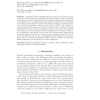Free Online Productivity Tools
i2Speak
i2Symbol
i2OCR
iTex2Img
iWeb2Print
iWeb2Shot
i2Type
iPdf2Split
iPdf2Merge
i2Bopomofo
i2Arabic
i2Style
i2Image
i2PDF
iLatex2Rtf
Sci2ools
100
Voted
MT
2010
2010
Metrics for MT evaluation: evaluating reordering
Translating between dissimilar languages requires an account of the use of divergent word orders when expressing the same semantic content. Reordering poses a serious problem for statistical machine translation systems and has generated a considerable body of research aimed at meeting its challenges. Direct evaluation of reordering requires automatic metrics that explicitly measure the quality of word order choices in translations. Current metrics, such as BLEU, only evaluate reordering indirectly. We analyse the ability of current metrics to capture reordering performance. We then introduce permutation distance metrics as a direct method for measuring word order similarity between translations and reference sentences. By correlating all metrics with a novel method for eliciting human judgements of reordering quality, we show that current metrics are largely influenced by lexical choice, and that they are not able to distinguish between different reordering scenarios. Also, we show t...
Related Content
| Added | 29 Jan 2011 |
| Updated | 29 Jan 2011 |
| Type | Journal |
| Year | 2010 |
| Where | MT |
| Authors | Alexandra Birch, Miles Osborne, Phil Blunsom |
Comments (0)

